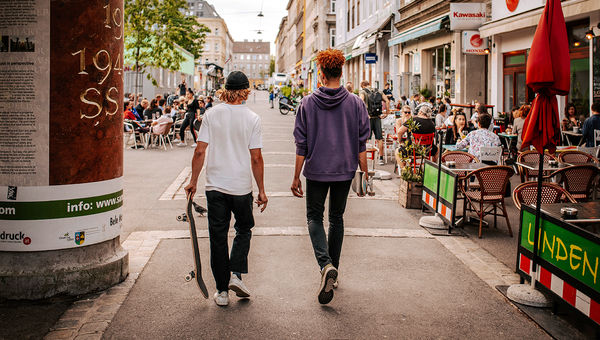A transformative trend to explore beyond well-trodden tourism areas and attractions in major urban destinations is gaining momentum, fueled by travelers of all generations who are seeking more experiences that are true to local culture.
The trend, which has been referred to as ‘life-seeing’ versus sightseeing, is documented in key research studies, including a 2023 report by booking.com that found 75% of survey participants said they want, “authentic experiences that are representative of the local culture.”
The American Express 2023 Global Travel Trends Report also identified a strong traveler focus on unique touring opportunities “that give them a taste of local culture and let them explore hidden gems that friends back home don’t know about.”
Tourism officials in major urban destinations have also observed the trend. “Guests now seek immersive experiences and a connection with local identity and lifestyle, valuing regional specialties, crafts and culture,” said Norbert Kettner, CEO of the Vienna Tourist Board. “They crave genuine, inspiring encounters away from the usual tourist crowds.”
Travelers who are seeking out those encounters are increasingly getting off well-worn tourism tracks and into lesser-known city neighborhoods.
“There has been a broad, clear trend of travelers seeking more unique experiences,” said Douglas Quinby, co-founder and CEO of Arival. A recent Phocuswright (sister brand to Travel Weekly) and Arival research report on The Outlook For Travel Experiences that surveyed more than 4,000 travelers across Europe and the U.S. found that 42% of travelers say ‘going off the beaten path’ is ‘very important’ to them when they travel. “This rises to 50% for millennials and Gen-X,” Quinby added.

© WienTourismus/Paul Bauer, Yppenplatz
In search of authenticity, personalization and a positive impact on communities
As leisure travel volume has roared back, travel advisors and tour operators are increasingly fielding requests from clients who want different, more personalized experiences on their urban explorations.
The lesser-known neighborhoods always have the ability to surprise you,” adds Gabriela Knöbl, tour guide and co-owner of Rebel Tours Vienna. “There is always a new door to open, a new restaurant to eat at, or a hidden courtyard to discover.”
The quest for more individualized and personal experiences is also fueling the trend to go beyond a city’s tourist hub.
Noted Gwen Kozlowski, president of Exeter International, “I hear over and over from travel advisors that their clients want to get off the beaten path, go outside of the box, do something that is ‘unGoogle-able’. For each traveler I think that means something different. Maybe it’s bragging rights, maybe it’s a personal connection. Or maybe they just don’t want to be in a herd on a bus tour, because where’s the magic in that?”
The American Express 2023 Global Travel Trends report also found that an increasing number of travelers want to know that the decisions they make while traveling can have a positive impact on the destinations they visit, and they want the money that they spend on vacation to support the local community.
A case in point is Vienna’s Heartbeat Streets initiative, “where conscious travelers seek to positively impact the destinations they visit, and at the same time enrich their own experiences,” Kettner said. “By venturing into less explored areas, our guests actively contribute to the development of the city and its communities.”

© WienTourismus/Paul Bauer, Spittelberg district
Who is traveling off the beaten track
Travelers most interested in venturing into a city’s lesser-known neighborhoods are generally repeat travelers who have already covered the main tourist attractions in that city.
“Nobody is going to go somewhere for the first time and not see the main tourist parts of a city,” said Kozlowski. “Generally, it’s a traveler that’s been there before and is ready to get off of that first-time route.”
Tour operators and travel advisors acknowledge that most of their clients want a mix that includes well-known tourist sites and attractions as well as unique, local experiences away from tourist hubs. The balance depends on the traveler, their level of experience with a particular destination, their age, length of stay, and their comfort level and style of travel in general.
Travelers pursuing their special interests are also a key driver of the trend to explore lesser-known neighborhoods. Culinary travel and food tours are an example. Recent research by the Virtuoso luxury travel network found that 70% of Virtuoso advisors say they have seen an increase in culinary travel, with 20% of travelers booking trips with food and wine as the primary focus. Nearly nine out of 10 advisors (87%) said authenticity is a major motivator, and 53% say hyper-local dining—not just farm-to-table, but neighborhood-to-table—is really taking off.
Neighborhood tourism here to stay
The steady increase in neighborhood tourism is likely to continue based on travelers’ growing desire for personal travel experiences, and the potential neighborhoods have to give visitors richer, deeper and more authentic encounters with a city and its people.
To learn more about diverse neighborhoods in cities, check out destination management companies, such as the Vienna Tourist Board. These organizations are like local experts and can help with providing travel advisors and tour operators with the best tips and insights into their cities.